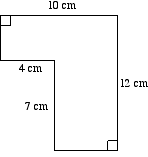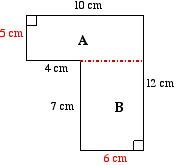|
The area of a shape is the amount of space inside the shape.
Areas can be found by counting squares or by using a formula.
|
Finding areas − by counting squares
For the rectangle shown you can count the number of squares.

Counting the squares, there are 21 square centimetres (squares with each side of length 1 cm)
|
| Finding areas − by using a formula

It can be seen that there are three rows of seven squares so a quicker way to get the area would be to multiply 3 by 7. This method gives an equation or formula, which works for any rectangle:
Area = length × width = 7 × 3 = 21 square centimetres.
|
Units
The units used for measuring areas depends on the units used for measuring the length of the shape.
If the units of a shape are not given, the area is given as units2.
A square metre is the area occupied by a square with each side 1 metre long. It is written as 1 m2.
Other common units for area are:
| Unit |
Symbol |
Units for measuring: |
| Square centimetre |
cm2 |
Small shapes |
| Square kilometres |
km2 |

Large areas such as the area of countries |
| Hectare |
ha |
Land area, e.g. farms |
Area Formulae 
|
Shape
|
Name |
Area |
|
|
Square |
A = length × width
= l2
|
|
|
Rectangle |
A = base × height
= b × h
= bh
|
Converting between units
To convert between units of area is sometimes confusing. A diagram often helps.
| Example |
|
Square metres into square centimetres
To convert 1 m2 into cm2.
Multiply by 10 000
|
|
From the diagram
1 m2 = 100 × 100 cm2 = 10 000 cm2
|
|
Hectares into square metres
Convert 1 ha into m2.
Multiply by 10 000
|
|
From the diagram
1 ha = 100 × 100 m2 = 10 000 m2
|
Composite Shapes
Composite shapes are shapes made up of shapes such as squares, rectangles, semicircles etc.
To find out the area of composite shapes, break the larger shape up into smaller ones for which you can find the area.
| Example |
First method |
|
Find the area of the following composite shape:

|
Break the shape up into two rectangles and find the missing measurements:

Area needed = area of A + area of B
= 10 × 5 + 7 × 6 = 92 cm2
|
| Another method |
Yet another method! |
|
Break the shape up into two other rectangles and find the missing measurements:

Area needed = area of C + area of D
= 4 × 5 + 12 × 6 = 92 cm2
|
Find the area of the bigger rectangle and subtract the un-needed bit.

Area needed = area of rectangle − un-needed bit
= 10 × 12 − 7 × 4 = 92 cm2
|
|